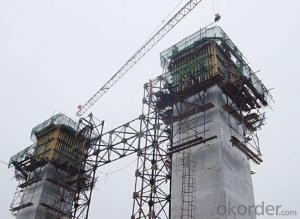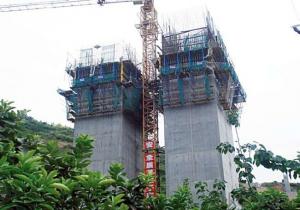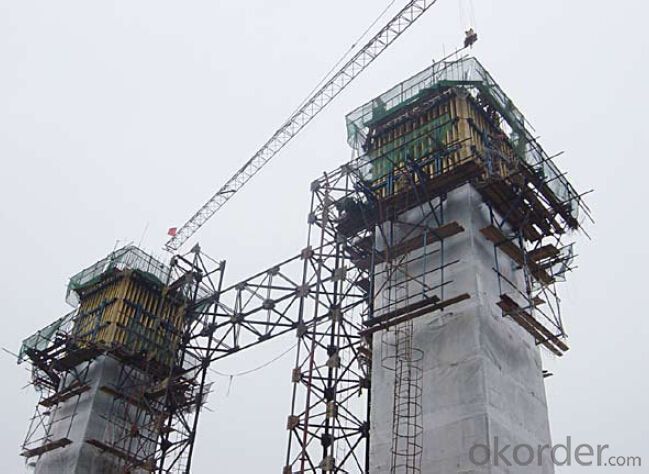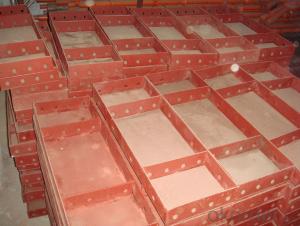Climbing Bracket for formwork and scaffolding system
- Loading Port:
- Tianjin
- Payment Terms:
- TT OR LC
- Min Order Qty:
- 50 m²
- Supply Capability:
- 1000 m²/month
OKorder Service Pledge
OKorder Financial Service
You Might Also Like
Climbing Bracket CB240 & CB210
They are framework brackets for supporting large-area wall formwork.
Typical applications for the CB240&CB210 are pier and column/shear wall/core walll/ in the
building.
CB210 has smaller size than CB240, it will be cost effective in some condition.
Characteristics:
◆ High bearing capacity
The high loading capacity of the brackets allow very large scaffold units. This saves the number
anchor points required as well as reducing climbing times.
◆ Simple moving procedure by crane
Through the strong connection of formwork together with the climbing scaffold, both can be moved
as a single climbing unit by crane. Thus valuable time-savings can be achieved.
◆ Fast striking process without a crane
With the retrusive set, large formwork elements can also be retracted quickly and a minimum of
effort.
◆ Safe with work platform
The platforms have assembled firmly with bracket and will be climbing together, without scaffolding
but can work safely in spite of your high location.
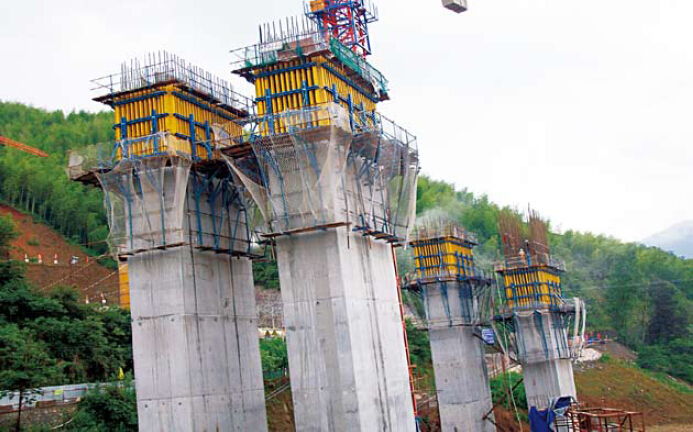

- Q: How does steel formwork affect the overall construction project management?
- Steel formwork can have a significant impact on overall construction project management. Here are a few ways it can affect the management of a construction project: 1. Time efficiency: Steel formwork is known for its durability and reusability, which can help save time during construction. With proper planning and coordination, steel formwork can be easily assembled and disassembled, allowing for faster construction progress. This time efficiency can lead to better project scheduling and improved overall project management. 2. Cost-effectiveness: Although steel formwork may have a higher initial cost compared to other formwork materials, its ability to be reused multiple times makes it a cost-effective choice in the long run. As a result, project managers can allocate their budget more efficiently, reducing unnecessary expenses and ensuring the project stays within the allocated cost limits. 3. Quality control: Steel formwork provides a smooth and uniform finish to concrete structures. This allows project managers to maintain high-quality standards throughout the construction process. By using steel formwork, project managers can ensure that the final product meets the required specifications and standards, reducing the need for rework and potential delays. 4. Safety and durability: Steel formwork is known for its strength and stability, making it a safe choice for construction projects. Its robustness helps prevent accidents on-site and provides a secure work environment for construction workers. Additionally, the durability of steel formwork ensures that it can withstand the pressures exerted during the concrete pouring process, reducing the risk of structural failures and subsequent rework. 5. Flexibility and adaptability: Steel formwork offers a high degree of flexibility, allowing project managers to adapt to changes and modifications in the construction plans. Whether it's adjusting the formwork design or reusing the same formwork for different parts of the project, the flexibility of steel formwork enables project managers to respond quickly to unforeseen circumstances, minimizing project disruptions. In conclusion, steel formwork can significantly impact the overall construction project management by improving time efficiency, cost-effectiveness, quality control, safety, and flexibility. Its durability and reusability make it a valuable asset for project managers, enabling them to deliver projects on time, within budget, and to the desired quality standards.
- Q: What are the different surface treatments available for steel formwork panels?
- There are several surface treatments available for steel formwork panels to enhance their durability and performance. Some of the common surface treatments include: 1. Galvanization: This involves immersing the steel formwork panels in a bath of molten zinc, which forms a protective layer on the surface. Galvanization provides excellent corrosion resistance, making the panels suitable for use in outdoor and highly corrosive environments. 2. Powder coating: This process involves applying a dry powder coating to the steel surface and then curing it under heat. Powder coating provides a durable and attractive finish, offering resistance to corrosion, abrasion, and chemicals. It also allows for a wide range of colors and textures. 3. Epoxy coating: Epoxy coatings are applied to the steel surface as a liquid and then cured to form a hard and protective layer. This surface treatment provides excellent resistance to corrosion, chemicals, and abrasion. Epoxy coatings are commonly used in environments where the formwork panels are exposed to harsh conditions. 4. Paint: Steel formwork panels can also be painted with various types of paint to provide a protective layer and improve aesthetics. Paints can offer resistance to corrosion, UV radiation, and wear, depending on the type and quality of the paint used. 5. Shot blasting: This treatment involves the use of high-speed steel shot or grit particles to blast the surface of the steel formwork panels. Shot blasting removes any rust, scale, or contaminants from the surface, providing a clean and roughened profile for better adhesion of subsequent coatings. 6. Hot-dip aluminizing: This process involves immersing the steel formwork panels in a bath of molten aluminum. It forms a thin layer of aluminum on the surface, providing excellent corrosion resistance and heat reflectivity. These different surface treatments for steel formwork panels offer varying levels of protection against corrosion, abrasion, chemicals, and other environmental factors. The choice of surface treatment depends on the specific application and the level of durability required.
- Q: Are all steel plates used for beam slab prefabrication
- Prefabricated components according to the number of times to determine the turnover, the same specifications of the components to reach more than 10, the general use of stereotypes steel template, the specification of the component is less, the general use of steel or steel formwork formwork
- Q: What are the different types of formwork corners used in steel formwork systems?
- There are typically three types of formwork corners used in steel formwork systems: external corners, internal corners, and chamfer corners. External corners are used to create sharp outside corners in the concrete structure. Internal corners are used to create sharp inside corners in the concrete structure. Chamfer corners are used to create beveled edges or rounded corners in the concrete structure. These different types of corners allow for flexibility in the design of the concrete structure and ensure a smooth and precise finish.
- Q: How does steel formwork contribute to the overall constructability of the project?
- Steel formwork contributes to the overall constructability of a project by providing a durable and reusable system for creating concrete structures. It allows for efficient and accurate construction, as it can be easily assembled and disassembled, reducing labor and construction time. Its strength and stability ensure that the formwork can withstand the pressure and weight of the concrete, resulting in a high-quality and structurally sound end product. Additionally, steel formwork offers flexibility in design and can be easily adjusted to accommodate changes during the construction process, enhancing the overall constructability of the project.
- Q: How does steel formwork affect the construction timeline?
- Steel formwork can significantly impact the construction timeline in a positive way. Due to its durability and strength, steel formwork offers faster installation and removal compared to traditional timber formwork. This expedites the construction process, allowing for quicker concrete pouring and curing times. Additionally, steel formwork provides better dimensional accuracy and reusability, reducing the time required for adjustments and replacements. Overall, the use of steel formwork can help streamline construction activities, leading to shorter project durations and improved efficiency.
- Q: Can steel formwork be used in extreme weather conditions?
- Yes, steel formwork can be used in extreme weather conditions. Steel is a durable and strong material that can withstand harsh weather conditions such as extreme heat, cold, rain, and wind. Unlike other materials like wood or plywood, steel formwork is not affected by moisture or temperature variations, making it suitable for use in extreme weather conditions. Additionally, steel formwork provides better stability and structural strength, ensuring the safety and integrity of the construction project even in adverse weather conditions. However, it is important to consider the proper protection and maintenance of steel formwork to prevent corrosion or damage that can occur over time due to exposure to extreme weather conditions.
- Q: Can steel formwork be used for tunnel construction?
- Yes, steel formwork can be used for tunnel construction. Steel formwork refers to the temporary or permanent molds made from steel that are used to shape and support concrete during the construction process. In tunnel construction, steel formwork is commonly used to create the tunnel lining, which provides structural support and protects the tunnel from external forces. Steel formwork offers several advantages for tunnel construction. Firstly, it is strong and durable, capable of withstanding the pressures and forces exerted on the tunnel structure. This makes it suitable for constructing tunnels in various ground conditions, including soft soils, rock, or even underwater. Secondly, steel formwork can be easily customized to the required shape and size, allowing for flexibility in tunnel design. It can be prefabricated off-site and then assembled on-site, reducing construction time and costs. Additionally, steel formwork is reusable, which further enhances its cost-effectiveness and sustainability. Furthermore, steel formwork provides a smooth and high-quality finish to the tunnel lining, ensuring the structural integrity and longevity of the tunnel. It also allows for the easy installation of other tunnel components, such as electrical conduits, ventilation systems, and drainage pipes. However, it is important to note that the selection of formwork material depends on various factors, including tunnel dimensions, construction method, ground conditions, and project requirements. Other types of formwork materials, such as timber or aluminum, may also be suitable for tunnel construction depending on the specific project needs.
- Q: What are the factors to consider when selecting steel formwork?
- To choose the right steel formwork, one must take into account various factors. Firstly, the strength and durability of the formwork are crucial. It should be able to bear the weight of the concrete and withstand the forces applied during pouring and curing. Additionally, it should maintain its structural integrity after multiple uses. Secondly, flexibility and adaptability are important considerations. The formwork should be easily adjustable and capable of accommodating different shapes and sizes of concrete elements. This is especially vital for complex or irregular structures. Next, the ease of assembly and dismantling plays a significant role. The formwork system should be quick and straightforward to put together and take apart, as this affects the overall construction timeline. The use of standardized components and a simple connection system can expedite this process. Furthermore, the surface finish of the concrete is a key factor, particularly for architectural projects. The steel formwork should provide a smooth and flawless surface without any visible marks or imperfections, ensuring a high-quality end result. Considering cost-effectiveness is also essential. The total cost of the formwork system, including the initial investment, maintenance, and reusability, should be taken into account. Although steel formwork may have a higher upfront cost, its durability and reusability make it a cost-effective choice in the long run. Safety is of paramount importance. The design and manufacture of the steel formwork should incorporate safety features such as non-slip surfaces, secure connections, and sufficient bracing to prevent accidents or collapses. Additionally, the environmental impact of the formwork material should be considered. Steel formwork is often considered more environmentally friendly than traditional timber formwork due to its ability to be reused and recycled. By considering these factors, construction professionals can make an informed decision when selecting steel formwork that meets their project requirements and delivers optimal results.
- Q: How does steel formwork affect the overall safety of a building project?
- Steel formwork plays a crucial role in enhancing the overall safety of a building project. Firstly, steel formwork is known for its high strength and durability, which ensures a stable structure during the construction process. This stability is essential in preventing accidents such as collapses or structural failures that can cause serious injuries or fatalities. Moreover, steel formwork provides a secure and reliable platform for workers to perform their tasks. The rigid structure minimizes the risks of slips, trips, and falls, which are common causes of accidents on construction sites. Additionally, steel formwork can be designed to include safety features such as handrails, guardrails, and non-slip surfaces, further enhancing worker safety. Another significant advantage of steel formwork is its fire-resistant properties. Steel is non-combustible, meaning it does not contribute to the spread of fire. This characteristic significantly reduces the potential for fire-related accidents in a building project, safeguarding both the workers and the structure itself. Furthermore, steel formwork is highly resistant to adverse weather conditions, such as heavy winds, rain, or earthquakes. This resistance ensures that the structure remains stable and secure even during extreme weather events, minimizing the risks of accidents or damage caused by these external factors. Lastly, steel formwork offers better quality control compared to other types of formwork materials. The precise and consistent dimensions of steel formwork reduce the chances of errors or inconsistencies in the construction process, resulting in a safer and more reliable end product. In conclusion, steel formwork positively impacts the overall safety of a building project by providing stability, a secure working platform, fire resistance, weather resistance, and improved quality control. These factors collectively contribute to reducing the risks of accidents, injuries, and structural failures, making steel formwork an essential component in ensuring a safe construction environment.
Send your message to us
Climbing Bracket for formwork and scaffolding system
- Loading Port:
- Tianjin
- Payment Terms:
- TT OR LC
- Min Order Qty:
- 50 m²
- Supply Capability:
- 1000 m²/month
OKorder Service Pledge
OKorder Financial Service
Similar products
Hot products
Hot Searches
